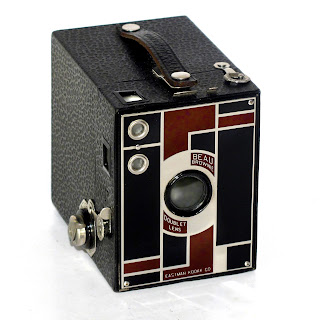ALBUMS THROUGH THE LAST CENTURY
My Grandma's Photo-album from 1912.
"Carte
de visite” was a kind of small
photograph, made on a thin print paper mounted on a thicker paper card made in the Standard
size 54 mm × 89 mm from 1870's into the early 20th century!!
At a fairly low price common people could be able to exchange a lot of them to all their friends and visitors.
Albums made in different sizes were made for 2,3 or 4 of those standard 54x89 cm pictures on each page.
Such albums for the collection and display of cards became a common fixture on
Victorian parlour tables.
A very rugged, torn and ugly old leather album contained a few surprises, that I found interesting.
 The pages were tastefully decorated. And under the last page of pictures a small Swiss mechanical music box was hidden. It still is able to play "Home sweet home" or as an alternative "Home to the range".
The pages were tastefully decorated. And under the last page of pictures a small Swiss mechanical music box was hidden. It still is able to play "Home sweet home" or as an alternative "Home to the range".
A very rugged, torn and ugly old leather album contained a few surprises, that I found interesting.
Inside it turned out to be a more exclusive sort of Album.
 The pages were tastefully decorated. And under the last page of pictures a small Swiss mechanical music box was hidden. It still is able to play "Home sweet home" or as an alternative "Home to the range".
The pages were tastefully decorated. And under the last page of pictures a small Swiss mechanical music box was hidden. It still is able to play "Home sweet home" or as an alternative "Home to the range".
This was the first "Music album" I came across.
But in some sense Albums for gramophone records could be called Music albums too.
These were probably used in the early years of the 1910's.
This strange album seems to be from the 1930's
A German course in typewriting using marsh music to get the proper rhythm. Made by Winklers Verlag (Gebrüder Grimm) Darmstadt. In those days the drudging labour of typing documents was generally assigned to female personnel. - But the idea with marsh music seems very strange to me.
Music albums in the sense I remember them looked like this. In the 1940's we had record changers able to play a whole album automatically.
LP records were introduced in the 1950's. Microgrooves increased the time of playing to an album on one record. To my surprise the phrase "Music album" continued to be used!
This little trick seems a bit absurd.
"Warning! Do not use as LP's on your old turntable. These are just the front of four 12 cm CD-records produced by Attention media."
ALBUM
The word is still used today by music artists, media and record companies meaning a collection of songs. But that's another story.



















































